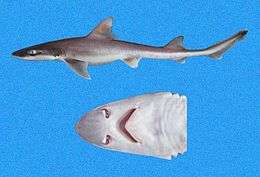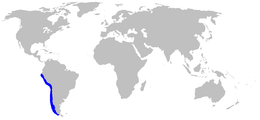Humpback smooth-hound
The humpback smooth-hound (Mustelus whitneyi) is a houndshark of the family Triakidae. It is found on the continental shelves of the tropical southeast Pacific, from Peru to southern Chile, between latitudes 3° S and 54° S, at depths between 15 and 210 metres (50 and 690 ft). Its conservation status is considered to be "vulnerable" by the IUCN.
| Humpback smooth-hound | |
|---|---|
 | |
| Scientific classification | |
| Kingdom: | Animalia |
| Phylum: | Chordata |
| Class: | Chondrichthyes |
| Order: | Carcharhiniformes |
| Family: | Triakidae |
| Genus: | Mustelus |
| Species: | M. whitneyi |
| Binomial name | |
| Mustelus whitneyi Chirichigno F., 1973 | |
 | |
Description
The humpback smooth-hound is a small shark growing to a length of up to 87 cm (34 in). It has a sturdy body with a moderately long, broad, sharply angled snout and large eyes, set widely apart. The mouth is fairly long and the upper lip furrows are longer than the lower ones. The teeth have a main pointed cusp and sometimes smaller subsidiary ones. The first dorsal fin is approximately triangular and the trailing edge is fringed with bare, dark-coloured collagen rods known as ceratotrichia. The pectoral fins are large and the pelvic fins moderately so. The caudal peduncle is short and the lower lobe of the tail fin is hardly curved in adults. The colour of this shark is plain grey or greyish-brown without any spots or barring.[2]
Distribution
The humpback smooth-hound is found in the eastern Pacific Ocean off the coast of Peru and Chile, between 1°N and 45°S. Its depth range is between 16 and 211 m (50 and 690 ft) but it is most common between 70 and 100 m (230 and 330 ft). It is found near the seabed, often on rocky shores, where it feeds on small fish and crustaceans such as crabs and mantis shrimps. It is viviparous and the females bear litters of five to ten young which are about 25 cm (10 in) long when born.[3]
Status
The humpback smooth-hound is fished for human consumption in Chile but more particularly in Peru, where it is more common.[1] Along with the spotted houndshark (Triakis maculata) and the speckled smooth-hound (Mustelus mento) it is known as "tollo" in its local fisheries, and of the three species it is the humpback smooth-hound that is the main target of the tollo fishery in Peru.[1] Landings averaging 11,000 tons of tollo per year were made in that country between 1965 and 1989, but quantities caught diminished thereafter. A minimum size requirement of 60 cm (24 in) was set in 2001 but was pitched so low as to have limited conservation effect. The International Union for Conservation of Nature (IUCN) has rated the status of the humpback smooth-hound as being "vulnerable" and considers more should be done to publicise and enforce the size limit.[1]
References
- Romero, M. (2007). "Mustelus whitneyi". IUCN Red List of Threatened Species. 2007: e.T63129A12619394. doi:10.2305/IUCN.UK.2007.RLTS.T63129A12619394.en.
- Compagno, L.J.V. "Humpback smooth-hound (Mustelus whitneyi)". Sharks of the World. Marine Species Identification Portal. Retrieved 2014-08-31.
- "Mustelus whitneyi Chirichigno F., 1973: Humpback smooth-hound". FishBase. Retrieved 2014-08-31.
External links
| Wikimedia Commons has media related to Mustelus whitneyi. |
- Humpback smoothhound (Mustelus whitneyi) media from ARKive

